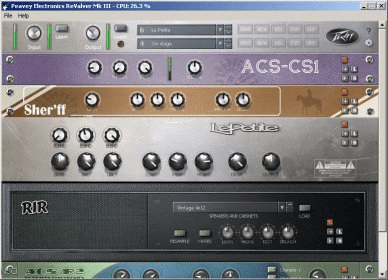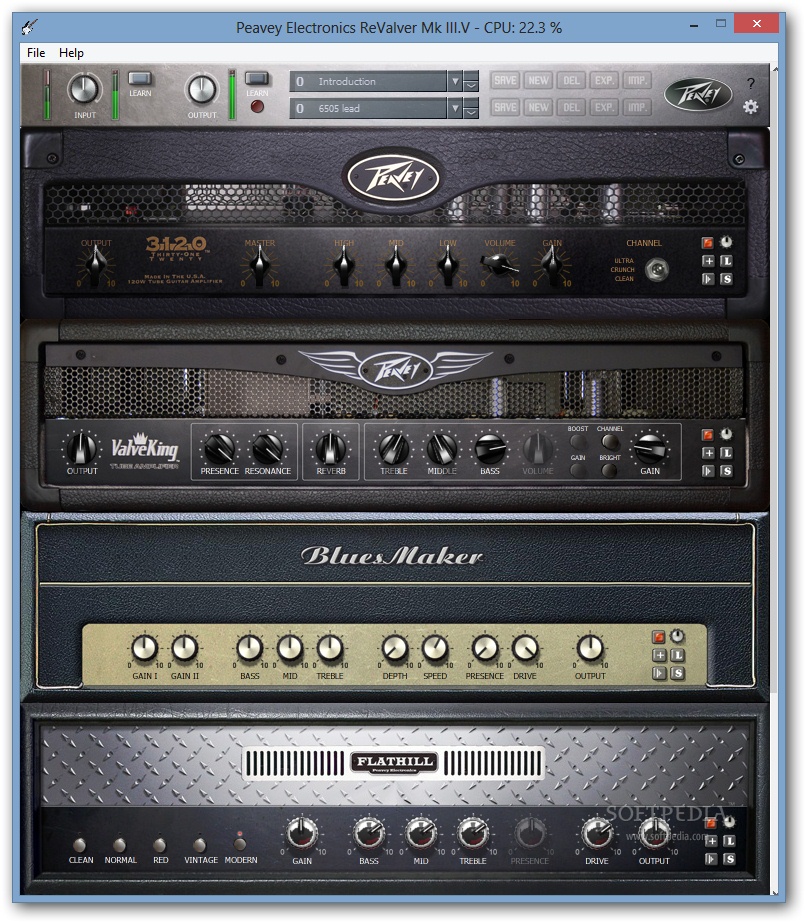
With amp modelling plug-ins becoming so good these days that they have truly become viable alternatives to real amps for both studio and live work, it takes quite a lot to make a product stand out from the rest of the crop. Peavey has always aimed for this lofty goal with their ReValver amp modelling software and with the release of version 4 they are definitely on the path to that glory.
Following on from ReValver Mk.III.V, version 4 is a complete rewrite, from the user interface and graphical elements right down to the modelling engine that powers the amp models. In an attempt to create some of the most realistic feeling and sounding amplifiers ever modelled in software, Peavey has decided to start from scratch and model each and every component of the supplied amplifiers using an engine called SPLICE. Previously SPLICE has been used by amp manufactures when designing new circuits as it allows you to model and map each component of the design and listen to the effect of every subtle change as if the real amplifier were in front of you. The problem was that this technology was previously too processor intensive for realtime use but Peavey has managed to pull the SPLICE tech into ReValver 4 whilst retaining realtime modelling abilities, giving the user all of the tonal and feel benefits that this ultra-real technology brings.
New Software Lets You Wire Up Custom Amps. ValveKing and Triple XXX guitar amps are available in ReValver in software format. Peavey ReValver Mk III will be available from authorized Peavey retailers in Q1 2008. 15 amp models, including Peavey 6505, JSX, Classic, ValveKing and Triple XXX. ReValver Mk III is a package that includes 15 amp models, 12 preamplifiers, nine power amplifiers, 19 stompboxes, 11 effects, more than 150 speaker simulations using real-time convolution and membrane modeling, and seven utility functions including tuners, analyzer, and splitters.
It’s obvious when you launch ReValver 4 that a huge amount of time and care has gone into the visual design of the software. The user interface is very easy to navigate and each of the amplifier modules has been recreated with a superb level of detail and fidelity. The main interface is divided into three sections, Stomps, Amps & Cabs and Effects with the ability to run two distinct signal chains containing each of these elements. The ‘Stomps’ section presents the user with a virtual pedal board on which a number of beautifully recreated stomp boxes can be placed in any order desired. The ‘Amps & Cabs’ section allow the user to select and place any combination of amp and cab modules with a dizzying array of options available to owners of the full package. The amps' modules are visually very similar to the actual amplifiers they are modelling (or identical in the case of Peavey’s own models) and are very easy to tweak, working just as you would expect and are used to.
Free Guitar Amp Software For Computer
The cab modelling is all done using Peavey’s RIR technology based on highly accurate convolution based modelling, where the cab, mic and mic position are sampled using an impulse response. Whilst this is standard practice now, ReValver 4 offers a huge array of cabs and mics with multiple positions and the ability to change the mic pattern and proximity or filter lows and highs and add room ambience.
The final ‘Effects’ section allows for the addition of high quality rack style effects modules such as reverbs, delays and modulation effects post the amp and cab section. Again, the visual flair is evident and the ease of use impressive. With two separate signal chains available and the ability to chain multiple modules and pedals together in any order in each of the sections, the number of tonal possibilities on offer is immense and limited only by the processing power available and the user’s imagination.
Peavey has added other impressive features to their newest version of ReValver including the highly useful ACT and GIG mode. ACT or ‘Audio Cloning Technology’ is available on the input and output modules and offers the ability for the user to profile their guitar and then change the tone to model various other guitar types and pickups. The output version allows modelling of entire signal chains or tone genre types, even down to famous guitar tones or for mastering a series of separate tones to work well together on a gig. This is the first time that we’re aware of this kind of feature being included in an amp modeller and it’s very successful, convincingly turning a custom Tele single coil guitar into a neck pickup 335 with ease!
GIG mode allows the user to load up to eight presets and seamlessly switch between them using a midi controller. Switching is immediate as the presets are preloaded into memory so this feature makes ReValver 4 truly gig worthy as a real amp replacement. A set of eight presets can be saved as a GIG preset allowing for entire set lists to be saved and recalled immediately. Practically all elements of each module can be mapped to a MIDI controller allowing for masses of expressive possibilities for live and studio use and the mapping process is made very easy thanks to an impressive MIDI Learn function.
Both in terms of tone and feel, ReValver 4 is a big success and classy performer. The SPLICE technology works very effectively to create a very realistic modeller in terms of dynamics and pick attack and to produce high quality, believable tones. Very importantly for this kind of software, the amps feel good to play as well as sounding great. Effects and stomp boxes are also very well modelled, reacting in the way you’d expect with no noise digital harshness to speak of. Of course, given all of the options available it is easy to create something that sounds horrible, but you can equally create incredible tones that fit directly into a mix with ease and that’s the key here - with a suitable amount of tweaking and tone searching you can create pretty much anything you want.
Because of the component nature of the modelling engine, daring users can even go into the schematic of each amp and alter the fundamental nature of the design with different tubes, resistor values and tolerances. This level of detail is only for the educated but it’s fun to see the schematic of each module and fiddle with the parameters - almost educational in fact! Of course, for those less daring individuals who just want to plug and play ReValver 4 comes with a ton of presets that are very nicely laid out for easy browsing with some really useful tones on offer as well as some of the crazy sounds that are achievable too. There’s too much on offer here to mention in one review but it would take a lifetime to exhaust all of the possible combinations and features on offer here.
Peavey offers a number of packages for ReValver 4 with a basic free version at the low end, shipped with two amp models and three cabs/mics plus a few effects, right up to the fully fledged Producer Pack featuring all of the stomps, amps, cabs, mics and effects that are available. Extra modules can be purchased separately from the amp store, allowing users to tailor a budget friendly package with just what they need, but given the modest price point of the Producer version it makes the most value minded sense to go directly for that and have everything at your finger tips.
ReValver 4 offers, to me, one of the most fully featured and best sounding and playing amp modellers on the market at a very good price point. With both standalone and VST/AU plug-in versions it is a fantastic choice for anyone considering taking amp modelling on their computer seriously whether for stage or studio. Highly recommended.
Read the full article
This article was originally published in issue #29
To read the article in its entirety, view the digital magazine
ReValver MKIII owners will be able to download the new RTAS-compatible version free at Peavey.com.Free Amp Software
Peavey ReValver Mk III is a 64-bit amplifier modeling software designed to capture the true characteristics of vacuum tubes while allowing users control over their tonality and gain structures.
ReValver Mk III models 15 guitar amplifiers, including several Peavey amps, through an algorithm that analyzes the interactions of the components at the circuit level, based on the amps' original schematics.


Features:
- 15 amp models, including Peavey 6505, JSX, Classic, ValveKing and Triple XXX.
- Modules in amp head, preamp and power amp formats.
- Two operation modes, with 64-bit and oversampling in HQ mode for hi-fi fanatics.
- FFT based convolution reverb, including sampled spring reverb.
- More than 150 speaker samples using real-time convolution and membrane modeling.
- Standard Tuner and Simul-Tuner with six independent tuners for tuning to presets.
Gtr3
U.S. MSRP $299.99For more info: www.peavey.com.